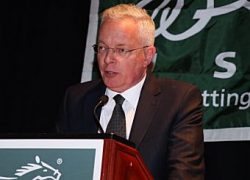USTA President Russell Williams declares RMTC doesn’t represent Standardbred racing
November 23, 2019,Columbus, OH — In an announcement from the Racing Medication & Testing Consortium on Wednesday (Nov. 20) regarding NSAID administration time and intra-articular injections, that organization inaccurately portrayed their relationship with the U.S. Trotting Association when they stated that, “The RMTC consists of 23 racing industry stakeholders and organizations that represent Thoroughbred, Standardbred, American Quarter Horse and Arabian racing.”

“A review of the RMTC release reveals an unjustified and regrettable misrepresentation,” said USTA President Russell Williams. USTA/Mark Hall photo.
“A review of the RMTC release reveals an unjustified and regrettable misrepresentation,” said USTA President Russell Williams. “The RMTC does not represent the Standardbred breed in any way. Only the United States Trotting Association and the Harness Racing Medication Collaborative can speak for the Standardbred breed regarding medication issues.”
HRMC Chairman Joe Faraldo echoed Williams’ declaration.
“As chairman of the USTA’s Harness Racing Medication Collaborative let me be quite clear that RMTC does NOT represent the Standardbred industry,” said Faraldo.
“The harness industry operates under altogether different racing and training regimens and is a more durable breed than our Thoroughbred counterparts,” explained Faraldo. “The genesis for such a proposed rule is founded on the unfortunate reaction to the Santa Anita catastrophe, which has gathered significant negative public attention but has no relationship to any Standardbred experience. Our incidence of catastrophic breakdowns is a statistical anomaly as compared to other breeds and hence such rules such as these, should under no circumstances be made applicable to the Standardbred industry.
“Rules such as these, referred to any state commission through RMTC or even RCI (Association of Racing Commissioners International), as its conduit, is not representative of rules more appropriately applicable to the harness racing industry and should therefore not be applied to it,” added Faraldo. “The HRMC shall provide the state racing commissions and others with appropriate regulations that are consistent with any and all integrity concerns related to permitted, therapeutic medications whether directly or through RCI.”
On Sept. 25, 2013, the Executive Committee of the USTA unanimously voted to reject RCI proposed model medication rules and in a separate unanimous vote, agreed that the USTA would immediately withdraw its membership from the RMTC.
“We have carefully considered the RCI proposals and have come to the conclusion that the physical characteristics of the breeds are significantly different. Trying to fit them together makes little sense,” said then USTA President Phil Langley. “We believe both breeds, Standardbreds and Thoroughbreds, will benefit from having rules concentrated solely on their needs.”
On May 8, 2018, the USTA, through the Medication Subcommittee of the USTA Board of Directors, established the HRMC, a group that includes both academic and practicing veterinarians.
The HRMC’s purpose is to assist in identifying and developing the scientific background for medication regulation in Standardbred racing. The USTA utilizes HRMC’s reports and supporting data to present to the RCI for dissemination to regulators in the various racing commissions.
